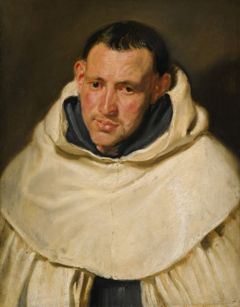All'asta londinese di Importanti Dipinti Antichi del 6 luglio 2011, Sotheby's metterà all'incanto Ritratto di un Monaco Carmelitano del grande pittore fiammingo del XVII Secolo, Sir Anthony Van Dyck

Lo scorso anno, durante una stima presso Sotheby's a Parigi, George Gordon,
Presidente del Dipartimento internazionale di Dipinti Antichi, notò un dipinto
di eccezionale qualità e osservò che composizione e tecnica erano riconducibili
allo stile del giovane Van Dyck nel periodo in cui lavorava presso lo studio di
Rubens. Numerosi studiosi che hanno avuto l'opportunità di analizzare il
dipinto, convengono nell'attribuirlo alla produzione di Van Dyck tra 1617-1620.
L'opera è presentata in asta con una stima di 600,000-800,000 GBP.
George Gordon, Presidente del Dipartimento internazionale di Dipinti Antichi
commenta così la scoperta: This is a very exciting discovery and a painting of
really extraordinary quality and visceral power. Van Dyck probably painted this intense portrait in Rubens' house in Antwerp and the genius of the artist's touch and the expressive power of his brushwork cannot fail to make a forceful impression on the viewer.
Sotheby's To Offer a Newly Discovered Work by Sir Anthony Van Dyck in its
London Sale of Old Master and British Paintings on 6th July 2011
Penetrating Portrait Has Descended in the Same Family for Over 200 Years and
Has Been Known as the “Confesseur de Rubens”
LONDON 10th JUNE 2011 - Sotheby's today announced that it will sell a newly
discovered portrait by the great 17th Century Flemish painter Sir Anthony Van
Dyck in its 6th July 2011 sale of Old Master and British Paintings in London.
The intense and psychologically penetrating portrait of a young Carmelite monk
is a hitherto unknown work, which Sotheby's has discovered to have been painted
by the youthful Van Dyck during the years he worked in Rubens' studio. The
painting is estimated to sell for £ 600,000-800,000.
Early last year Sotheby's Paris office did a routine valuation to appraise
artwork, and noticed a painting of extraordinary quality which the family had
owned for at least two centuries and which has always been known as the
“Confesseur de Rubens”.
Sotheby's George Gordon, Co-Chairman, Old Master Paintings, Worldwide, observed
that while Rubens' portraits are always formally composed, the current work,
especially the way the young monk's head is turned to one side, creates an
impression of spontaneity. In addition, the brushwork in the present picture,
which is painted in oil on oak panel, is clearly legible throughout most of the
painting and is more reminiscent of Anthony Van Dyck when he worked in Rubens'
studio, than of his teacher. Specifically, the use of thick paint to denote
highlights in the sitter's habit is a characteristic of Van Dyck's personal
style at this date, and can be seen in a series of paintings the artist made of
the Apostles.
Of the large number of scholars who have had the opportunity to study this
picture at first hand, the consensus view is that it is by Van Dyck towards the
end of the period during which he worked with Rubens in Rubens' studio, circa
1617-1620.
Commenting on the discovery, George Gordon, Sotheby's Co-Chairman, Old Master
Paintings, Worldwide, said: “This is a very exciting discovery and a painting
of really extraordinary quality and visceral power. Van Dyck probably painted
this intense portrait in Rubens' house in Antwerp and the genius of the
artist's touch and the expressive power of his brushwork cannot fail to make a
forceful impression on the viewer.”